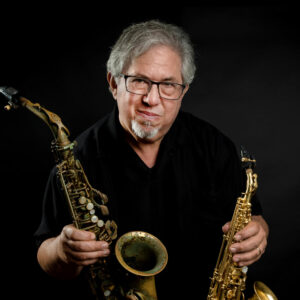The American Muse
Elliott Carter composer
Michael Torke composer
Alec Wilder composer
Calvin Hampton composer
Steve Cohen composer
Aaron Copland composer
Paul Cohen arranger
Caryl Florio composer
The New Hudson Saxophone Quartet
Paul Cohen soprano
Avi Goldrosen alto
Noah Getz tenor
Tim Reudeman baritone
While the saxophone quartet has a relatively short history compared to traditional classical its wind and string counterparts, its repertoire has been rapidly expanding. Combining the suppleness of a string quartet, power of a brass quintet, and extroverted color of a wind quintet, the saxophone has truly blossomed as a unique and accepted voice by composers and listeners.
With composers such as Glass, Cage, Berio, Flagello, Xenakis, Wuorinen, Keuris, and Bolcombe writing substantial pieces, its place in today’s classical music scene is secure and growing. On THE AMERICAN MUSE, the New Hudson Saxophone Quartet performs American music that spans beyond a century, from 1879 to 1999. Whether it is the classicist Florio, jazz-inspired Wilder, nostalgic Copland, or post-minimal Torke, each work is of a singularly different nature yet all identifiable as American in style and spirit.
Listen
Stream/Buy
Choose your platform
Track Listing & Credits
| # | Title | Composer | Performer | |
|---|---|---|---|---|
| 01 | Saxophone Quartet #2 (1998): Andante | Steve Cohen | The New Hudson Saxophone Quartet | 7:33 |
| 02 | Saxophone Quartet #2 (1998): Scherzo | Steve Cohen | The New Hudson Saxophone Quartet | 3:52 |
| 03 | Saxophone Quartet #2 (1998): Adagio | Steve Cohen | The New Hudson Saxophone Quartet | 7:05 |
| 04 | Saxophone Quartet #2 (1998): Allegro Giocoso | Steve Cohen | The New Hudson Saxophone Quartet | 3:58 |
| 05 | July (1995) | Michael Torke | The New Hudson Saxophone Quartet | 7:47 |
| 06 | Four Piano Blues (1926–1948): freely poetic | Aaron Copland, arr. Paul Cohen | The New Hudson Saxophone Quartet | 2:48 |
| 07 | Four Piano Blues (1926–1948): soft and languid | Aaron Copland, arr. Paul Cohen | The New Hudson Saxophone Quartet | 2:39 |
| 08 | Four Piano Blues (1926–1948): muted and sensuous | Aaron Copland, arr. Paul Cohen | The New Hudson Saxophone Quartet | 2:45 |
| 09 | Four Piano Blues (1926–1948): with bounce | Aaron Copland, arr. Paul Cohen | The New Hudson Saxophone Quartet | 1:11 |
| 10 | Fugue (1976) | Calvin Hampton | The New Hudson Saxophone Quartet | 6:24 |
| 11 | Saxophone Quartet (1973): Movement No. 1 | Alex Wilder | The New Hudson Saxophone Quartet | 2:52 |
| 12 | Saxophone Quartet (1973): Movement No. 2 | Alex Wilder | The New Hudson Saxophone Quartet | 2:37 |
| 13 | Saxophone Quartet (1973): Movement No. 3 | Alex Wilder | The New Hudson Saxophone Quartet | 2:02 |
| 14 | Saxophone Quartet (1973): Movement No. 4 | Alex Wilder | The New Hudson Saxophone Quartet | 3:50 |
| 15 | Canonic Suite for Quartet of Alto Saxophones (1945/1981): Fanfare | Elliot Carter | The New Hudson Saxophone Quartet | 1:03 |
| 16 | Canonic Suite for Quartet of Alto Saxophones (1945/1981): Nocturne | Elliot Carter | The New Hudson Saxophone Quartet | 2:43 |
| 17 | Canonic Suite for Quartet of Alto Saxophones (1945/1981): Tarantella | Elliot Carter | The New Hudson Saxophone Quartet | 1:39 |
| 18 | Quartette (1879): Andante | Caryl Florio | The New Hudson Saxophone Quartet | 3:00 |
| 19 | Quartette (1879): Allegro | Caryl Florio | The New Hudson Saxophone Quartet | 3:46 |
Recorded June–July 1999 at Town Hall New York City & July–August 1999 at West Center Church in Bronxville NY
Recording Session Producer Andor Toth
Recording Engineer Jeremy Tressler, Enota Sound & Andor Toth, David Smith, Triton Sound
Editors Jeremy Tressler, Andor Toth
Mastering Thomas Bethel, Acoustik Music Ltd.
Artistic Director André Gillles Duchemin
Graphic Design franclygraphic.com
Cover Illustration by Anique Taylor
Notes by Paul Cohen
Translation Guy Marchaund
Executive Producer Bob Lord
A&R Director Brandon MacNeil
A&R Jeff LeRoy
VP of Production Jan Košulič
Audio Director Lucas Paquette
VP, Design & Marketing Brett Picknell
Art Director Ryan Harrison
Design Edward A. Fleming
Publicity Kacie Brown, Aidan Curran, Chelsea Kornago
Digital Marketing Manager Brett Iannucci
Artist Information

Paul Cohen
Paul Cohen is a sought-after saxophonist for orchestral and chamber concerts and solo recitals. He has appeared as soloist with the San Francisco Symphony, Richmond Symphony, New Jersey Symphony, Charleston Symphony, and the Philharmonia Virtuosi. His many solo orchestra performances include works by Debussy, Creston, Ibert, Glazunov, Martin, Loeffler, Husa, Dahl, Still, Villa-Lobos, Tomasi, and Cowell. He has also performed with a broad range of orchestras, including the New York Philharmonic, Metropolitan Opera (NYC), American Symphony Orchestra, Cleveland Orchestra, Santa Fe Opera, New Jersey Symphony, Oregon Symphony, San Diego Symphony, Long Island Philharmonic, Group for Contemporary Music, Greenwich Symphony, and New York Solisti.
The New Hudson Saxophone Quartet
The New Hudson Saxophone Quartet is a rare combination: an ensemble dedicated to presenting American music with a string quartet approach and a beautiful, blending saxophone sound. Their repertoire can range from newly commissioned works by Robert Sirota and Robert Kyr to classic original repertoire by 19th-century American composers Caryl Florio and the 20th century Alec Wilder.

